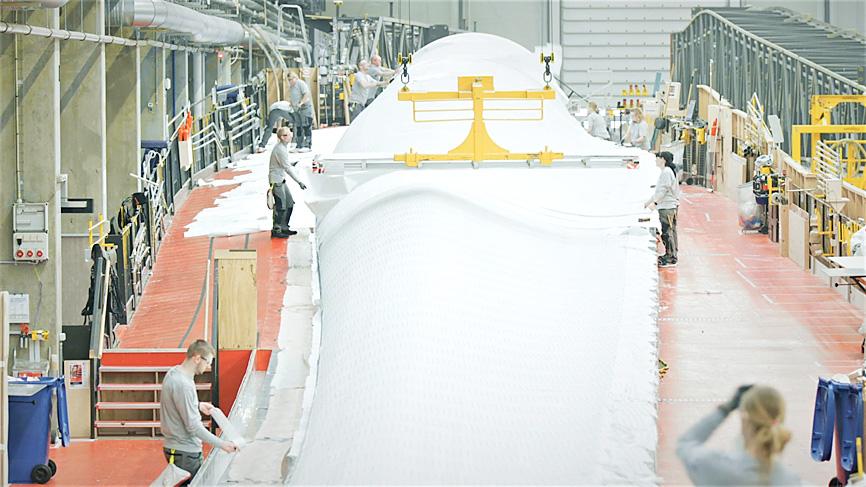Wind turbine maker Siemens Gamesa Renewable Energy SA of Germany and Taiwan-based Swancor Holding Co (上緯投控), a developer of green recycling material, have launched a strategic partnership to develop recyclable wind turbine blades as part of their commitment to supplying environmentally friendly products.
In a statement released on Friday, Swancor said the two partners’ recycling solutions are expected to fulfill the concept of a green circular economy and hit a milestone for environment, social and governance (ESG) actions toward carbon neutrality and new materials innovations.
They are to focus on efforts to recover and recycle components of wind turbine blades after they are decommissioned, Swancor said.

Photo courtesy of Siemens Gamesa Renewable Energy SA
The recovered materials, resins and glass fibers can be used in other applications, while the recycling process would not produce waste solvents and waste gas, as it has a low-carbon footprint, which would resolve challenges that arise from landfill disposal or incineration, it added.
Swancor’s efforts in developing recyclable thermosetting epoxy resin, used to make the turbine blades, is undergoing supplier qualification at Siemens Gamesa.
Swancor hopes to supply the German firm with its “EzCiclo” recyclable thermosetting epoxy resin and “CleaVER” degradation liquid, it said in a statement.
For its part, Siemens Gamesa led its peers in launching the first recyclable wind turbine blade in the world in September last year and has received orders from energy suppliers such as RWE AG, EDF Renewables, wpd AG and Vattenfall in Europe.
At the end of this year, the construction of RWE’s Kaskasi offshore wind farm in Germany is scheduled to be completed, and it would be the first offshore wind farm in the world to introduce Siemens Gamesa’s recyclable wind turbine blades.
Siemens Gamesa has also signed an agreement to install equipment to produce 3 gigawatts of offshore wind power in Taiwan.
Swancor, which began research and development of recyclable thermosetting epoxy resin in 2015, said the recyclable blade technologies aim to help Taiwan reach the goal of using fully recyclable wind turbine blades as it develops offshore wind energy.
“Our goal is to provide customers with fully recyclable solutions for the components of wind turbines,” Niels Steenberg, general manager of Siemens Gamesa Offshore for Asia-Pacific, said in the statement.
“Through the cooperation with Swancor, the recyclable blade resin technology allows the blade resin, glass fiber and carbon fiber to be recycled and reused. We aim at creating a sustainable blade resin life cycle which will become a strong steppingstone for Taiwan to achieve net zero carbon emissions by 2050,” Steenberg said.
Formosa Plastics Corp (台塑), the flagship entity of the Formosa Plastics Group (台塑集團), is Swancor’s strategic partner in related recyclable solutions.
Siemens Gamesa signed an agreement with Swancor for the Taiwanese manufacturer to supply recyclable wind turbine blade resin in 2018, the first of its kind in Taiwan.
In the statement, the German company said Swancor’s supplies of resin in the 2018 agreement have been used in 20 offshore wind turbines in Taiwan, helping the country to locally produce materials for wind energy development.

The US dollar was trading at NT$29.7 at 10am today on the Taipei Foreign Exchange, as the New Taiwan dollar gained NT$1.364 from the previous close last week. The NT dollar continued to rise today, after surging 3.07 percent on Friday. After opening at NT$30.91, the NT dollar gained more than NT$1 in just 15 minutes, briefly passing the NT$30 mark. Before the US Department of the Treasury's semi-annual currency report came out, expectations that the NT dollar would keep rising were already building. The NT dollar on Friday closed at NT$31.064, up by NT$0.953 — a 3.07 percent single-day gain. Today,

‘SHORT TERM’: The local currency would likely remain strong in the near term, driven by anticipated US trade pressure, capital inflows and expectations of a US Fed rate cut The US dollar is expected to fall below NT$30 in the near term, as traders anticipate increased pressure from Washington for Taiwan to allow the New Taiwan dollar to appreciate, Cathay United Bank (國泰世華銀行) chief economist Lin Chi-chao (林啟超) said. Following a sharp drop in the greenback against the NT dollar on Friday, Lin told the Central News Agency that the local currency is likely to remain strong in the short term, driven in part by market psychology surrounding anticipated US policy pressure. On Friday, the US dollar fell NT$0.953, or 3.07 percent, closing at NT$31.064 — its lowest level since Jan.

Hong Kong authorities ramped up sales of the local dollar as the greenback’s slide threatened the foreign-exchange peg. The Hong Kong Monetary Authority (HKMA) sold a record HK$60.5 billion (US$7.8 billion) of the city’s currency, according to an alert sent on its Bloomberg page yesterday in Asia, after it tested the upper end of its trading band. That added to the HK$56.1 billion of sales versus the greenback since Friday. The rapid intervention signals efforts from the city’s authorities to limit the local currency’s moves within its HK$7.75 to HK$7.85 per US dollar trading band. Heavy sales of the local dollar by

The Financial Supervisory Commission (FSC) yesterday met with some of the nation’s largest insurance companies as a skyrocketing New Taiwan dollar piles pressure on their hundreds of billions of dollars in US bond investments. The commission has asked some life insurance firms, among the biggest Asian holders of US debt, to discuss how the rapidly strengthening NT dollar has impacted their operations, people familiar with the matter said. The meeting took place as the NT dollar jumped as much as 5 percent yesterday, its biggest intraday gain in more than three decades. The local currency surged as exporters rushed to